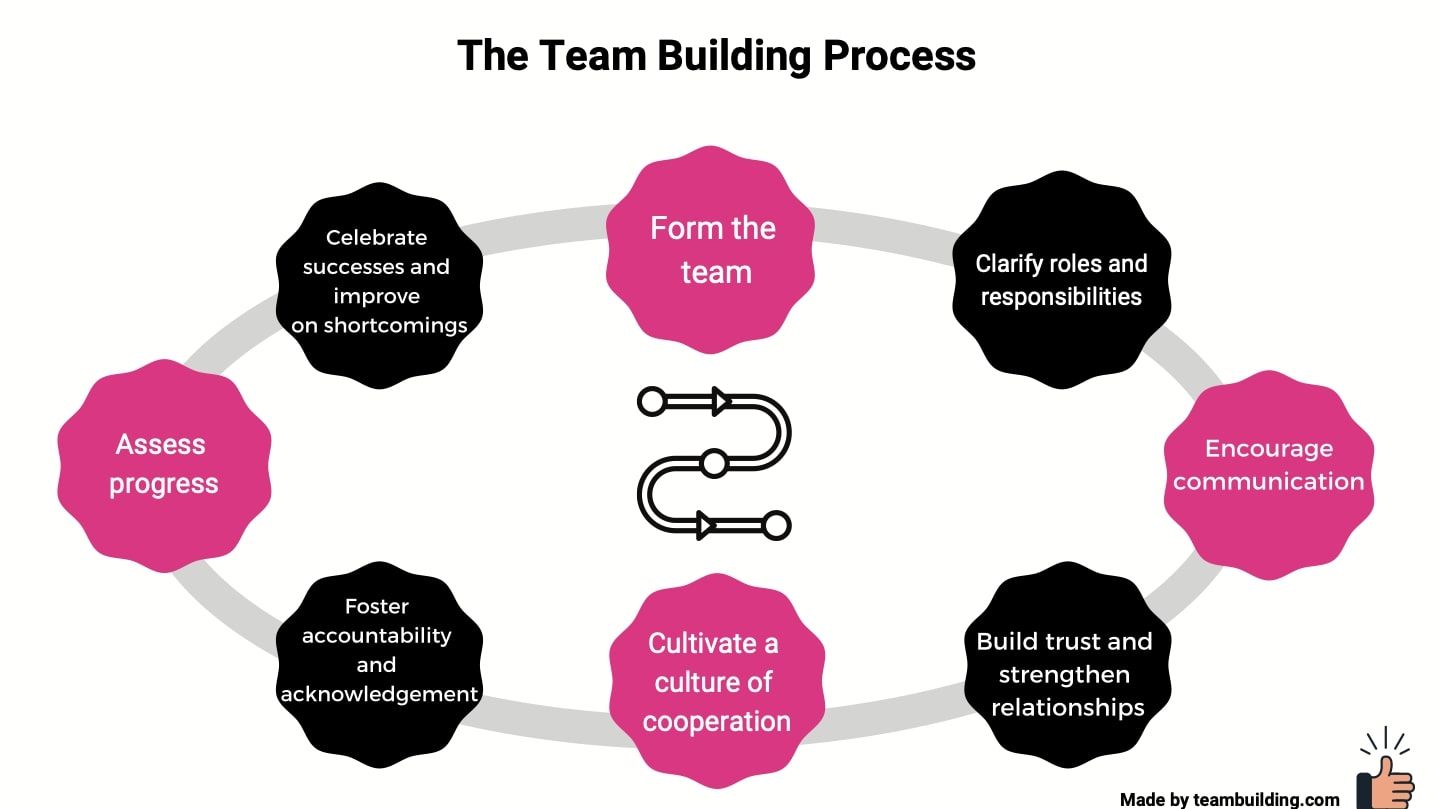You found our guide to the team building process.
The team building process is a step-by-step system for transforming a group of employees into an effective and collaborative unit.
This process can include team building tasks, team building stages and different types of team building.
Team building occurs in eight stages:
- Form the team
- Clarify roles and responsibilities
- Encourage communication
- Build trust and strengthen relationships
- Cultivate a culture of cooperation
- Foster accountability and acknowledgement
- Assess progress
- Celebrate successes and improve on shortcomings
Here is a diagram of the stages:

Read on for a summary of each phase.
How to do the team building process
1. Form the team
Step one is to form your team. Whether this step involves hiring, re-organizing current company structure, or a mixture of both, you should select team members of varying skills and experiences that compensate for each other’s weaknesses and complement each other’s strengths.
Also, you should consider teammates’ personalities and work styles. You want to minimize but not necessarily eliminate conflict. Teams that clash and bicker will make little progress, while teams that never disagree may fail to examine matters from multiple perspectives. You should aim for balanced teams. Remember that your teams do not need to be perfect right out of the gate. In fact, few, if any teams will gel instantly. Team building takes time and practice, but can improve your team’s dynamics. Yet team building is no miracle cure. Team activities alone may not fix teams with incompatible skill levels and dispositions, so better to select the right members for your team from the get go.
When choosing your teammates, you should analyze your current team makeup and identify any gaps. Consider what you want your team to achieve and which abilities will help the team reach those goals.
2. Clarify roles and responsibilities
Each team member has a role to play, but those roles must be clear for your teams to succeed. If every member of a baseball team chased after the ball, then a game would devolve into chaos. Similarly, if your team members are unsure of responsibilities, employees may duplicate work or miss tasks.
Clarifying roles cuts down on conflict and eliminates stress and frustration. When teams understand the part of each individual player, teammates can confidently tackle tasks and produce timely results. As the Harvard Business Review notes, collaboration increases when roles are unambiguous.
To clarify roles, introduce team members and highlight each teammate’s position, skills, and experience. At the start of each project, either assign tasks or oversee the team’s delegation of duties. You should always be aware of team member responsibilities to ensure an even workflow distribution. You can always reallocate tasks and send help as necessary during projects, but establishing clear positions helps everyone set realistic expectations and stay on track.
Want some free team building tools?
$49 value (100% free)
- 100+ fully tested icebreaker questions
- 24+ themed Bingo generators
- 5+ PDFs (including the 8% Rule)
- 2024 team building calendar
- and more...

Enter your email for instant access
3. Encourage communication
Communication is an important part of teamwork. Teams that communicate effectively waste less time and are more productive. Turnaround time improves when teammates respond quickly and concisely. When teammates can convey an idea or a vision, other teammates can follow instructions without circling back for clarification. Good conversation skills also decrease conflict, as employees are less likely to misunderstand or misinterpret clear messages.
Discussion is also one of the most effective team building tools. Casual conversations build rapport and camaraderie among teammates, forming bonds and fostering trust among your team.
For these reasons, establishing lines of communication should be one of the first steps you should take when building your teams.
You should also ensure that your team has the means to communicate, especially if the team is remote. You can set up your teams with communication software such as Slack, Blink, or Asana, and provide additional contact information for all team members.
Check out this list of communication games for more ideas.
4. Build trust and strengthen relationships
Trust is essential to teams. To achieve great performance, colleagues must depend on each other. Teammates must believe that other group members will complete the work quickly and correctly. Team members must also feel comfortable confronting other teammates and approaching teammates for help. Employees who feel comfortable with colleagues take more creative risks and report higher levels of satisfaction. Not to mention, trusting colleagues waste little time questioning teammate’s intentions or second-guessing others’ work.
One way to foster trust is by strengthening the relationships between teammates. Forming emotional connections makes us more likely to trust. After all, when we interact regularly with individuals, those folks are likely to act in our best interests to maintain the bond. Also, forming relationships means recognizing different personality facets and understanding our colleagues on a deeper level.
You can facilitate relationships on your team by creating opportunities for natural interactions like casual coffee chats or team dinners. You can also engage in relationship-building team building activities such as storytelling workshops and common traits.
Here is a list of trust building games for work.
5. Cultivate a culture of cooperation
Employees need to work together to achieve success. Organizations are not groups of individuals working solo, but rather teams collaborating towards a shared goal. Teams must adopt an “us” mentality to thrive in the modern workplace. Otherwise, employees will not utilize all the resources at their disposal.
As a leader, you should acclimate your crew to a teamwork culture. Some of your employees may have always acted alone, and may need time to get used to depending on other group members.
You can encourage cooperation by gently deferring questions and tasks to other team members. For instance, you can say, “Janice is a compliance superstar. She could explain this much better than I can, and I’m sure she’d be happy to help!”
You can also play collaboration-centric team building games like scavenger hunts, escape rooms, and improv games. Team building board games are a vastly underrated cooperation-based activity. Cooperative gaming teaches players to join forces against the game instead of competing against each other.
Here is a list of team building games to try.
6. Foster accountability and acknowledgment
This step ties in with clarifying roles and responsibilities. A team member must not only understand expectations and positions, but must also follow through on those duties. For a team to function effectively and maintain trust, each teammate must own individual contributions. When teammates fulfill promises and deliver consistent quality work, the team can reach goals without hitting slowdowns or snags.
To foster accountability on your team, you should aim to create a safe environment where employees are not afraid to own up to mistakes and admit shortcomings. You can actively encourage your crew to reach out to teammates for help and advice, as opposed to shouldering the burden alone and underperforming. You should address missteps, but it helps to frame the conversation as “what could you have done better?” instead of “what did you do wrong?” In its best form, accountability is more an opportunity for improvement than a punishment. You do not correct an employee to embarrass, but rather because the whole team depends on individual effort.
The New York Times Business guide to building a successful team sums up the sentiment best with a great quote from Shopify executive Tobi Lütke: “Every time you work with someone at the company, the trust battery between the two of you is either charged or discharged, based on things like whether you deliver on what you promise.”
On the other side of the coin, it is also important for the team to recognize a job well done. By acknowledging accomplishments and achievements as a team, you motivate your people to deliver their best work and boost employee morale. You can promote acknowledgement by starting rituals like team kudos, where each team member shares a compliment about a colleague via anonymous post-it-note or shout-out on a team chat.
7. Assess progress
As you progress through the team building process, you should periodically measure your team’s growth. At this point, you may decide to revisit your baseline and assess which teamwork competencies your group mastered, and which could use more work. Feel free to reinforce any teamwork skills you feel your team could still enhance.
You can assess progress by asking for feedback from your team. You can ask your team to fill out individual evaluations using programs like SurveyMonkey or Google Forms, or you can prompt a frank discussion during a meeting so that you can analyze the situation together. Feel free to ask your team for recommendations for improvement.
It also helps to make observations and take notes at the beginning of the team building process so that you can compare your group’s present dynamic to past behavior.
8. Celebrate successes and improve on shortcomings
Team building requires effort, and when you achieve success in any or many of the team building steps, you should take time to acknowledge the win. In fact, experts encourage you to celebrate small wins with the team consistently. Acknowledging headway re-energizes and motivates the team and helps prevent burnout. By recognizing that your hard work produces results, you inspire your employees towards continued excellence. However, you need to praise the achievements in a timely manner so that employees can feel the full benefits.
You should also move fast to correct shortcomings. If you delay making improvements, then your team may lose momentum. The best time to improve is when you first discover a flaw. The sooner you revamp your approach, the sooner your team can flourish. Feel free to return to any of the previous steps as many times as necessary.
Here is a list of ways to celebrate with a virtual team, and ideas for recognizing employee of the month.
Conclusion
You may notice that the diagram at the beginning of this article is circular, not linear. Team building is an ongoing process, not a one-and-done operation. Your team roster may shift, outside circumstances may change, and you may need to restart the cycle. You may also find that you may need to revisit or reinforce certain steps. The team building process does not always follow the same order. You may need to spend more time on one phase than another, and may need to move backwards and re-emphasize particular competencies. You and your team can move at your own pace, as long as you address all parts of the process.
For more tips, check out this list of books on teamwork, this guide to team management skills and these team building program examples.
